
AC/DC are an Australian rock band formed in Sydney in 1973 by Scottish-born brothers Malcolm and Angus Young. Their music has been variously described as hard rock, blues rock, and heavy metal, but the band calls it simply "rock and roll".

Highway to Hell is the sixth studio album by Australian hard rock band AC/DC, released on 27 July 1979. It is the first of three albums produced by Mutt Lange, and is the last album featuring lead singer Bon Scott, who died on 19 February 1980.

Ronald Belford "Bon" Scott was an Australian singer and songwriter. He was the lead vocalist and lyricist of the hard rock band AC/DC from 1974 until his death in 1980.

Let There Be Rock is the fourth studio album by Australian rock band, AC/DC. It was originally released on 21 March 1977 in Australia on the Albert Productions label. A modified international edition was released on 25 July 1977 on Atlantic Records. It was the last AC/DC album to feature Mark Evans on bass.
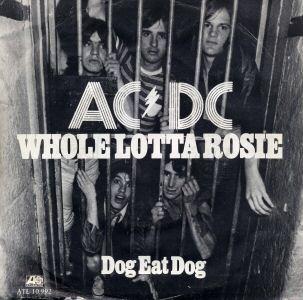
"Whole Lotta Rosie" is a song by Australian hard rock band AC/DC. It is the eighth and final track on the band's fourth Australian album, Let There Be Rock, released in Australia in March 1977, and was written by Angus Young, Malcolm Young, and Bon Scott. It is also the eighth and final track on the international version of the album, released in June the same year.

"You Shook Me All Night Long" is a song by Australian hard rock band AC/DC, from the album Back in Black. The song also reappeared on their later album Who Made Who. It is AC/DC's first single with Brian Johnson as the lead singer, replacing Bon Scott who died of alcohol poisoning in February 1980. It reached number 35 on the USA's Hot 100 pop singles chart in 1980. The single was re-released internationally in 1986, following the release of the album Who Made Who. The re-released single in 1986 contains the B-side(s): B1. "She's Got Balls" ; B2. "You Shook Me All Night Long".

T.N.T. is the second studio album by Australian hard rock band AC/DC, released only in Australia, on 1 December 1975. This was the band's first release with bassist Mark Evans and drummer Phil Rudd, although the last two tracks feature George Young and Tony Currenti, both of whom previously appeared on High Voltage.

If You Want Blood You've Got It is the first live album by Australian hard rock band AC/DC, and their only live album with Bon Scott as lead vocalist. It was originally released in the UK and Europe on 13 October 1978, in the US on 21 November 1978, and in Australia on 27 November 1978. The album was re-released in 1994 on Atco Records and in 2003 as part of the AC/DC Remasters series.
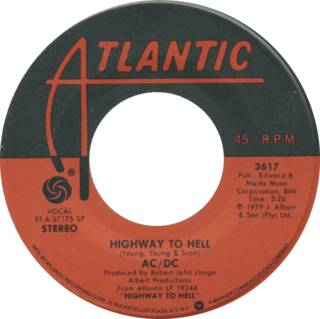
"Highway to Hell" is a song by Australian rock band AC/DC. It is the opening track of their 1979 album Highway to Hell. It was initially released as a single in 1979.

Let There Be Rock: The Movie – Live in Paris is a live double album by the hard rock band AC/DC, released as "Disc Two" and "Disc Three" of the Bonfire box set in 1997. It is also the soundtrack to the film AC/DC: Let There Be Rock. It is the last album Bon Scott recorded with the band before he died, just two months before his death and was released posthumously.

Live from the Atlantic Studios is a live album by AC/DC released on the Bonfire box set. The album was recorded live at the Atlantic Recording Studios in New York, on 7 December 1977 and all tracks were remixed by George Young. This was an official Radio Station/Promo release by Atlantic Records. It was initially released on LP in 1978, and later on CD (1986). AC/DC's performance was the first in a series of promotional concert-events for Atlantic Records acts. Catalog # LAAS 001. The CD version was officially released to fans in 1997 as part of the Bonfire collection. Prior to that, this album was widely bootlegged among AC/DC fans.

"It's a Long Way to the Top (If You Wanna Rock 'n' Roll)" is a song by Australian hard rock band AC/DC. It is the first track of the group's second album T.N.T., released only in Australia and New Zealand on 8 December 1975, and was written by Angus Young, Malcolm Young and Bon Scott. The song combines bagpipes with hard rock instrumentation; in the middle section of the song there is a call and response between the bagpipes and guitar. The original recording is in B-flat major, but it was played live in A major.

"High Voltage" is a song by Australian hard rock band AC/DC. It was first released in Australia as a single in July 1975, though it is the eighth track of their second Australian album T.N.T., the release itself was issued as a stand alone single. The song was written by Angus Young, Malcolm Young and Bon Scott, and peaked at #48 on the UK Singles Chart in 1980.
"Let There Be Rock" is a song by Australian hard rock band AC/DC. It is the third and title track of their album Let There Be Rock, released in March 1977, and was written by Angus Young, Malcolm Young, and Bon Scott.
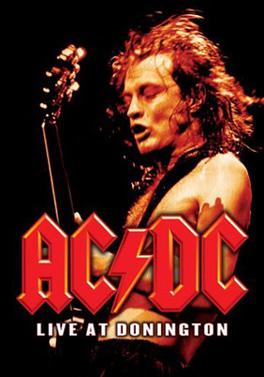
Live at Donington is the DVD recording of the Australian rock band AC/DC‘s show at Donington Park on 17 August 1991, directed by David Mallet; it was the band's third Monsters of Rock festival. The two-hour show was performed before 72,500 spectators and included real cannons, the Hells Bell, an inflatable Rosie and two inflatable Anguses: one to the right of the stage, and one in the back of the stage during Hell Ain't a Bad Place to Be. It was filmed in 35 mm Panavision and had 26 cameras that included one situated inside a helicopter. The DVD includes special features such as stereo and 5.1 surround sound, Iso-cam versions of certain songs for different band members, and audio commentary from Angus and Malcolm Young.
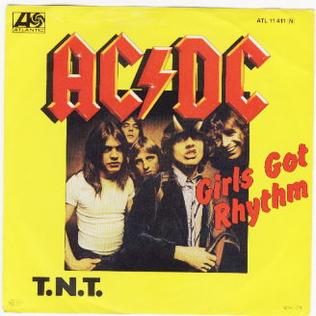
"Girl's Got Rhythm" is a song by Australian rock band AC/DC. It is found on their 1979 album Highway to Hell. The song was released as a single the same year.

Dirty Deeds Done Dirt Cheap is the third studio album by Australian hard rock band AC/DC, originally released only in Europe and Australia in 1976. The album was not released in the United States until 1981, more than one year after lead singer Bon Scott's death. This was also AC/DC's first album in its entirety to be recorded with the same lineup, rather than including at least one track recorded with a different bassist or drummer.

The Razors Edge World Tour was a concert tour played by the hard rock band AC/DC, in support of their twelfth studio album The Razors Edge. This tour had 5 legs around the world lasting 12 months starting on 2 November 1990 in Worcester, Massachusetts, finishing on 16 November 1991 in Auckland, New Zealand.
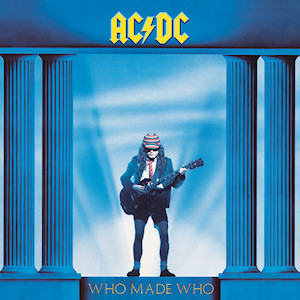
Who Made Who is a soundtrack album by Australian hard rock band AC/DC. Released on 26 May 1986, the album is the soundtrack to the Stephen King film Maximum Overdrive. The album was re-released in 2003 as part of the AC/DC Remasters series.
The Back in Black Tour was a concert tour by the Australian hard rock band AC/DC in support of their seventh studio album Back in Black, which was released on 25 July 1980.
















